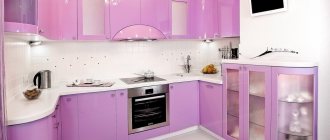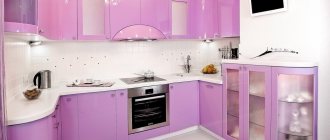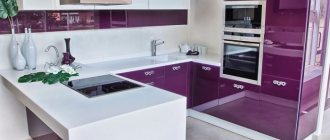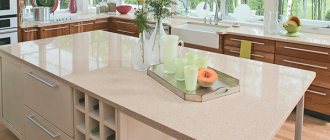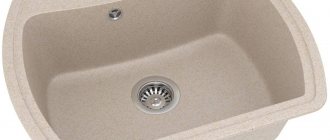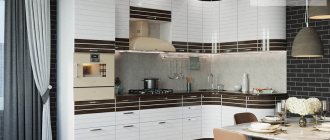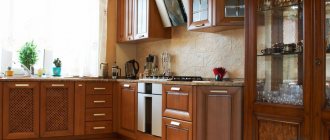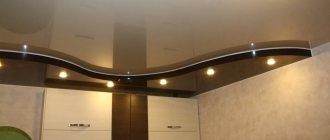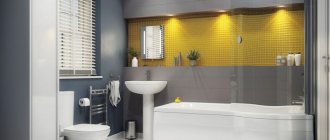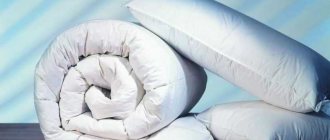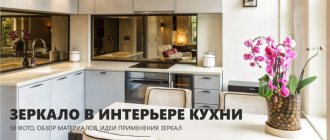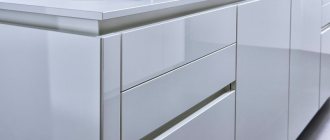A good kitchen set is the key to convenience and quality food preparation. This process is accompanied by high temperatures and humidity; not all furniture can withstand such loads. In addition to the practical side, external attractiveness is also important: often this is where guests are received or gathered for a family dinner. In this article we will tell you which kitchen façade material to choose in order to combine practicality and beauty.
What are acrylic facades?
At first glance it may seem that the panels are made of plastic. This is wrong. Thin MFD or chipboard panels are covered with special sheets of polymethacrylate, more often called acrylic.
MDF panels coated with acrylic.
This helps to ensure not only strength, which is important for furniture facades, but also wide design possibilities, as well as a characteristic glossy shine. MDF with acrylic coating is absolutely harmless, does not emit toxins when heated, and with proper care will last for many years.
High-gloss acrylic panels are easy to clean and do not fade over time. In addition, the properties of acryline help it not to absorb dirt and grease.
Acrylic MDF
These products with a pleasant glossy surface are made using the same technology as plastic ones - an MDF board is covered with a thin layer of acrylic.
Photo from source: znakotveta.ru
Tabletop Cedar 3043/S Semolina gray
Advantages
- does not peel off;
— deep mirror gloss effect;
- not susceptible to fading when exposed to direct sunlight;
— manifestation of resistance to chips and other types of damage;
- strength.
Flaws
— all prints and stains are clearly visible, so special care is required;
- impossibility of milling.
Manufacturing technology of acrylic facades for kitchens
There are two ways to manufacture such facades: one-sided and two-sided. In the first case, the acrylic sheet is glued only to the outer part, leaving the inner part untreated. In the second, both sides of MDF or chipboard are glued, providing the doors with the same appearance from the inside and outside.
The coating is glued using a special glue (for example, Cosmofen or Akrifix), and then placed under a press. In this case, the sections are covered with a waterproof acrylic edge, which prevents peeling of the decorative layer. The thickness of such a facade often does not exceed 16-18 millimeters.
A more expensive option is solid acrylic panels up to four millimeters thick, edged with aluminum. Metal adds strength to them, comparable to chipboard, but they are much more difficult to maintain and are quite expensive.
Enameled MDF facades
MDF consists of wood fiber panels, the density of which is medium, so the façade can be given any desired shape. Enamel painting technology is used in the automotive industry: the surface of the panel is primed, covered with layers of paint, and varnished on top. Each layer that is applied is then sanded.
The result is a beautiful and durable finish. It is a worthy competitor to acrylic. But, on the other hand, in order to avoid minimizing the risk of chips and scratches, it is necessary to be more careful when handling such facades.
Photo from source: sar-mebel.ru
Advantages
— a variety of shades and color combinations that can be viewed on special layouts;
— you can choose the color of the facades to match curtains, wallpaper, paints, and other interior elements;
— the ability to create different textures;
— the ability not to change appearance for many years;
- simple care, easy to clean from dirt - just use water in which a small amount of cleaning agent is diluted;
— the ability to produce straight as well as round/wavy shapes;
— minor defects are eliminated;
— homogeneous doors, no edges;
— suitable for sets with carved, radius doors.
Flaws
- relatively expensive price, since the manufacturing process is not cheap;
— under the influence of UV rays the material burns out;
— if the coating is glossy, grease marks and palm prints, stains will be especially visible;
— high risk of chipping;
— you need to work with sharp objects especially carefully, because they easily damage such surfaces;
— the use of aggressive detergents is contraindicated.
Pros and cons of kitchens with acrylic facades
In addition to appearance and ease of installation, such facades have a number of advantages:
- Wear resistance. The strength of acrylic reliably protects it from damage due to impacts and scratches. In addition, damaged acrylic panels can be reconstructed to their original appearance. With proper care, they will last up to 20 years.
- Acrylic does not react to temperature changes and is resistant to heating up to 160 degrees. It does not deform when exposed to water, and does not fade from sunlight.
- Grease, soot and dust are not absorbed into the surface ; it can be easily cleaned with a simple detergent and a soft cloth. We recommend: Once every three to four months, treat facades with sprays that help maintain a glossy shine, for example, Weiss or Cosmofen.
- Large selection of design solutions. Acrylic panels are presented in a wide palette. In addition, you can decorate them with prints or airbrushing or decoupage.
- The glossy structure due to its reflective properties makes the room lighter and more spacious .
- Acrylic panels, unlike plastic ones, do not release toxic impurities into the air when heated. Therefore, acrylic can be considered an environmentally friendly material.
However, it was not without its drawbacks:
- Due to the manufacturing technology, acrylic facades are quite expensive . The cost of a solid acrylic facade can reach $600 per linear meter, and an acrylic coating can cost $100. At the same time, taking into account the quality, the price can be considered relatively affordable: the long service life fully pays for the costs of manufacturing and installation.
- The glossy surface is very difficult to handle. It does not scratch or chip, but any fingerprints and dust become much more noticeable. You will have to regularly wipe away streaks and stains. Please note: Special grease-repellent polishes will help prevent the problem.
- High shine. The disadvantage is conditional, but over time many people begin to be annoyed by the glossy mirror structure of the acrylic facade.
What is the choice based on?
A kitchen is a room that cannot provide furniture in good conditions, simply because food is prepared here. Consequently, the humidity here will always be at an elevated level, as will the air temperature, as well as its sudden changes, the presence of soot in the air, flying drops of fat, and the risk that aggressive liquids will reach the surface. In order for a kitchen set to last for a really long time, you need to choose a material that can successfully withstand all this.
Photo from source: hoog.design Tabletop Cedar 706/S Royal opal
What is better to choose for kitchen facades: acrylic or plastic?
As mentioned above, acrylic is much more environmentally friendly than plastic. But is this the only difference? We offer a comparative table of the two materials.
| Acrylic facades. | Plastic facades. | |
| Gloss. | Clearly expressed, with a mirror shine. | Compared to acrylic, plastic is duller. There are matte options. |
| Temperature resistance. | It tolerates heating up to 160 degrees without releasing toxic impurities. | Good HPL or CPL plastic can withstand temperatures up to 140 degrees, but cheap options begin to release toxins at 80 degrees, so they should not be placed near the stove. |
| Term of use. | With proper use - up to 20 years. | After just a couple of years, it may begin to fade from heat and direct sunlight. |
| Price. | High-quality acrylic will cost you quite a lot. | Affordable price. |
| Facade type. | Only deaf. | Deaf and radius. |
Let's summarize: Acrylic facades are more durable and reliable, but the price is not encouraging. At the same time, plastic facades are more affordable, but they are more capricious in everyday use and they cannot be placed next to heat sources.
MDF
MDF is easy to process, so using it, it is possible to make furniture with decorative carvings and bent elements. In addition, the raw materials are compressed more densely than in the case of laminated chipboard, so MDF is more durable. Kitchen facades made of MDF are covered with: plastic, enamel, veneer, film, and also acrylic.
Of course, MDF provides enormous opportunities for decorating a kitchen in any style and creating any design.
Photo from source: panfasad.com
What color should acrylic facades be made in?
The design palette for acrylic facades is extremely wide. Many colors and shades, the possibility of decorative design. We invite you to look at the most popular options among designers - perhaps you will find your ideal kitchen.
A white acrylic kitchen is a great choice for small spaces. Due to the color and glossy texture, it reflects light, visually enlarging the room and making it lighter and more spacious. However, keep in mind that such facades are very difficult to maintain - all the dirt and drops of grease are visible on the white surface, so you will have to wash the set often.
An interesting solution is a black and white acrylic kitchen . The classic combination looks very catchy thanks to the mirror shine. However, it is important to maintain a balance here: it is better if the colors are combined with each other, and do not overwhelm each other.
If such a combination seems boring to you, dilute it with another shade - it is better to choose bright colors, for example, pink, light green, blue.
Bright red is on trend right now, but we recommend being careful with it. Aggressive tones quickly tire the eyes, so monochromatic design in this case is not the best choice. Dilute it with calmer, pastel shades - beige, gray, golden.
The same applies to yellow kitchens. However, it all depends on the chosen tone. Soft colors will make the kitchen fresh and brighter, but bright colors require a muted edging.
A monochrome black kitchen is a bold but very stylish solution. It is important to pay attention to details: any inappropriate accessory, the slightest contamination - and the impression is ruined.
Features of enamel coating
Enamel kitchen facades are made by applying a multi-layer coating consisting of varnish and dye. Before treating the kitchen structure with this composition, it is primed with a special solution. This gives greater durability to paint components and increases adhesion to wood.
In this case, by selecting different types of paint, it is possible to achieve one of two types of coating:
- matte enamel layer;
- glossy kitchen surface.
One of the advantages in terms of aesthetics of using enamel is the incredibly huge selection of shades. This allows you to formulate a concept for the furnishing style and change the contrast of the interior design. Other benefits of enamel coating include:
- environmental friendliness of the material and the entire furniture collection;
- ease of care;
- resistance to moisture agents;
- variability of texture.
Another advantage is the possibility of using enamel in kitchen designs of complex configurations, with radial shapes, and with a block structure.
Manufacturers of acrylic kitchen facades
Acrylic panels are produced by dozens of manufacturers with very different pricing policies.
We offer you the TOP 3 manufacturers popular in Russia:
- Bel Viso using NIEMANN panels. Polish acrylic facades are one of the most famous. A wide selection of decorative designs, a huge color palette and high quality. The price, however, is appropriate - from $150 per linear meter.
- The Sidak company , located in the Leningrad region, will also not please you with the price tag - from $140 per meter. However, the factory goes through the full production cycle: from the panel to the finished facade, which affects the quality.
- Fordom is a more budget option. Turkish facades will cost you an average of $90 per meter. Of course, you can also find cheap acrylic facades. But be careful - most often the tempting price tag hides a low-quality coating or simple plastic, sometimes not even heat-resistant.
Frame facades with an MDF profile base
Combined models are especially popular today. In their case, frames are created from MDF into which glass, plastic, and rattan mats are inserted. The frame itself is covered with PVC film/veneer.
Photo from source: kubaturamall.ru Tabletop Cedar 7093/E Concrete
Advantages
- affordable price;
- light weight - lighter than standard options, which extends the service life of furniture mechanics;
- sizes that are not included in the standard category will not increase the cost;
— creation of original and expressive kitchen design projects, thanks to the variety of materials used as inserts.
Flaws
— negative influence of humidity;
— complexity of daily care;
— coating may peel off;
- Frame fastening may also become weaker over time.
Reviews from real owners of acrylic kitchens
If you look at the reviews of people who bought acrylic facades for their kitchen, you will notice one common point - everyone admires their beauty and durability, but emphasizes the capriciousness of their care. Most often, this means the need for regular cleaning.
However, some people think that wiping the facade once a month is enough, but the only disadvantage is the cost.
And some people don’t like the need to use special care products.
Sometimes a change in shade depending on the lighting is noted. Therefore, be careful with pastel colors - in the twilight they may appear dull.
However, the reviews are unanimous on one thing - acrylic facades are reliable, durable and beautiful.
Advantages and disadvantages of plastic
What's good about this material?
- Reliable and wear-resistant.
- Serves up to 25 years.
- Does not fade under the influence of ultraviolet radiation.
- Does not deform from sudden changes in temperature or humidity.
- Withstands minor mechanical impacts.
- It looks expensive and neat.
- Glossy surfaces visually expand the space.
- Can imitate other, more expensive materials.
- Not afraid of exposure to detergents (except for abrasives).
The only drawback is, perhaps, the relatively high price.
How to care for acrylic facades
As can be seen from the reviews, the main problem with acrylic facades is their maintenance. How to properly care for the panels?
Now we'll tell you:
- Do not use aggressive abrasive detergents.
- When choosing what to wash the panel with, stick to the mildest possible detergents - for example, regular dishwashing detergent.
- Use lint-free soft cloths.
- Wipe the surface regularly to prevent fingerprints and dirt from accumulating on it.
- Use polish for acrylic kitchen facades - it will make cleaning much easier.
Let's summarize: With proper care, an acrylic facade is an excellent choice for kitchen design. A beautiful, eco-friendly and durable set will become a real decoration of the room. Among the disadvantages, we note the high price - however, taking into account the durability of such furniture, it is completely justified.
Features of acrylic kitchens
After processing, polymethyl acrylate is applied to the MDF board, which is the basis of the product. This combination improves technical characteristics and enhances the strength of the facade. MDF is a stabilized material that does not deform under the influence of moisture and temperature, which means that acrylic will not peel off from the surface over time. Chipboard is a cheaper alternative, and manufacturers rarely use it with polymethylacrylate, since such furniture is short-lived.
Structure of façade MDF panel with acrylic coating
Constructions
Acrylic itself is a super-strong and non-plastic material. To adapt it to different headset designs, the following manufacturing technologies are used.
- Acrylic panel. The basis is an MDF board, which is treated with a hardening solution and primed for subsequent application of the design. Using a printer, an image appears on the surface, and then the product is covered with acrylic. Since the material has no color, a coloring pigment of the desired color is added to it during the production process. After applying acrylic in a layer of 1–3 mm, the surface is treated with ultraviolet radiation. Thus, the furniture does not fade in the sun and retains its presentable appearance for many years. Next, the monolithic slab is cut into panels of the required size. Such acrylic facades for the kitchen can only be acute-angled and even in the form of regular geometric shapes.
- Film. To produce curved facades, manufacturers use acrylic film, which retains plasticity and is applied to uneven surfaces. First, multilayer paper is impregnated with absorbents and coated with resin, which includes polymethyl acrylate. Next, the MDF and film are sent under a hot press so that the top layer is firmly fixed to the base. Thus, the acrylic fits tightly to the slab, melts and transforms into a monolithic coating 1 mm thick.
Linear kitchen with façade acrylic panels
Kitchen with acrylic facades made using film technology
Acrylic structures also include products painted with acrylic paint or coated with a layer of glossy enamel. These options also have their fans, since the design of such furniture is very easy to change, you just need to cover the surface with a different color. Modern manufacturers offer a wide range of paints and enamels with such rare colors as krakolet, chameleon, metallic, etc.
Types of facades
Since facades are a multi-layer structure, the issue of finishing is also important when choosing a product. The following types of cladding are distinguished.
- Postforming. This technology is used only with acrylic film. Here the flaps are rounded, and the film bends around the base in such a way as to capture 2 edges. The upper and lower edges are sealed with PVC film, which significantly reduces the number of joints. Thus, both outside and inside the furniture has the same color. Previously, postforming was the name for a chipboard coating made of plastic with a gloss or laminate effect, which was applied under high temperature to the entire surface, including the ends. The technology is very similar to modern technology, but the materials used are different.
- Edge. Here the ends are covered with PVC or acrylic film. There are two types of coating: either one-sided or two-sided.
- Aluminum frame. In this case, acrylic panels are inserted into an aluminum frame. Such facades look very stylish and do not lose their shape. The width of the frame can vary depending on the kitchen design: from thin, barely noticeable frames to thick panels. Special care should be taken when caring for this product, as aluminum can darken over time if aggressive cleaning products containing abrasive particles are used.
Facades in an aluminum frame are not afraid of chipping, but do not tolerate abrasive detergents
Acrylic kitchens with straight surfaces are much more common than kitchen sets with curved facades
Kitchens with acrylic facades photo examples
Comparison of composition and technical characteristics
Acrylic paint contains:
- pigments and fillers needed to determine paint color
- functional additives.
- monomers of acrylic copolymers, this is the base of the paint
- auxiliary monomers that affect the properties of the paint
Functional additives include emulsifiers that affect the surface coating, organic solvents affect the strength of the connection, and stabilizers prevent component particles from settling.
The enamel contains the following components:
- solvents
- pigments for color determination
- additives to determine various functions
- varnish
- fillers
The main differences between the compositions of enamel and acrylic are that the enamels seem to be fused to the surface and delight with their durability, but have a pungent odor. Acrylic, in turn, is characterized by quick drying of the painted area and protects it from damage.
Comparison of consumption per 1 m2
The consumption of enamel or acrylic depends on the surface itself. If the surface is rough, you will have to apply several layers to achieve the desired effect. If the surface to be painted is prepared for paint according to all standards and has a glossy surface, then for acrylic paint 1 - 2 layers and 0.2-0.25 liters per square meter are sufficient. If you cover the surface of the product with it, then when covering in 2 layers you need 100 - 180 grams.
Important! To find out how much acrylic or enamel you need for painting, you need to calculate the perimeter of the product to be painted and take into account the number of coated layers, usually up to 2.
Plastic headsets: what to consider when choosing
The basis of the plastic facade is the same MDF and chipboard, glued under a press with roll or sheet PVC film. Typically, standard wood-imitation cabinets are made from such panels, but a wide variety of textures and shades are possible. The joints and sections of such facades are treated with polymer and aluminum edges.
When choosing such a kitchen, you should consider the following points:
- Manufacturing plastic products is cheaper than analogues.
- It washes well, there are no visible water stains or streaks on it.
- PVC film can be used to cover milled surfaces.
Choice by budget
Check out prices for custom kitchens. If your budget is unlimited, then order from solid wood - this is the best material that nothing can compare with. If you are looking for the cheapest kitchen, then a set made of laminated chipboard will suit you.
The rest of the materials are in the middle price category, and it’s worth choosing based on their characteristics.
